
MAY CONTAIN NUTS

Search Shorpy
SHORPY ART

Framed or unframed, desk size to sofa size, printed by us in Arizona and Alabama since 2007. Explore now.
Join and Share
Ad-Free Shorpy
Shorpy is funded by you. Patreon contributors get an ad-free experience.
Learn more.

Recent comments
- Side Winder
- Air Quality?
- Sojourner Truth riot
- None were so blind(ed)
- The less famous sister
- Good ol' days?
- Rise and Fall
- Goo Goo Ga Joob
- Ticket Retention
- Not the only one
- Vagaries of War
- Killed by Amtrak
- Back to the Future
- Wanted --
- If you can't stand the light
- Centralized Traffic Control, I believe
- What's really happening
- Heckuva remote control!
- Sometimes — Things Go Bump!
- I SEE THE LIGHT
- Union Switch and Signal Company
- Get That Light Out Of My Eyes
- Eggs. Eggs. Eggs. The Egg Man is Here!
- Foreboding caption
- Famous Hollywood faces
- Not just S&P
- re: Those things in the jar
- Up In Smoke
- Medical Smoking
- Quick fix
Member Photos
The Shorpy
Print Emporium
Print Emporium
Search Shorpy
Search results -- 30 results per page
- Mission School: 1908
- ... by the Episcopal Church. Average attendance 15." Photo by Lewis Wickes Hine. View full size.
(The Gallery, Education, Schools, Kids, ... Posted by Dave - 03/08/2014 - 12:09pm -
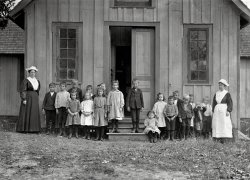
- Jonas Glass Works: 1909
- ... one finds, occasionally, a few younger workers." Photo by Lewis Wickes Hine. View full size.
(The Gallery, Factories, Lewis Hine) ... Posted by Dave - 12/30/2013 - 6:10pm -
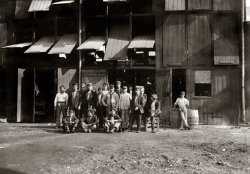
- Chiaroscuro: 1909
- ... Millville, New Jersey. View full size. Photograph by Lewis Wickes Hine.
(The Gallery, Lewis Hine) ... Posted by Dave - 12/10/2007 - 3:23pm -
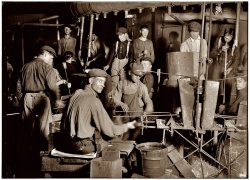
- Messenger 43: 1913
- ... [red light district] some." Photograph and caption by Lewis Wickes Hine. View full size.
(The Gallery, Kids, Lewis Hine) ... Posted by Dave - 02/24/2008 - 6:20pm -
![Messenger 43: 1913 Houston, Texas. October 1913. "Fourteen-year-old Western Union Messenger #43. Works until 10:30 p.m. Goes to Reservation [red light district] some." Photograph and caption by Lewis Wickes Hine. View full size.
(The Gallery, Kids, Lewis Hine)](https://www.shorpy.com/files/images/05530u.thumbnail.jpg)
- Waxahachie Pickers: 1913
- ... up to 15 and more. Two adults." Glass negative by Lewis Wickes Hine. View full size.
I made 50 cents I did that once in my ... Posted by Dave - 04/04/2016 - 9:58am -
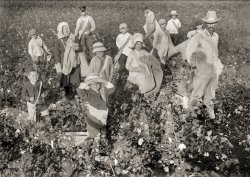
- 'Pick-up' in the Park: 1916
- ... River, Massachusetts. View full size. Photograph by Lewis Wickes Hine.
(The Gallery, Lewis Hine, Sports) ... Posted by Dave - 09/08/2011 - 1:02pm -
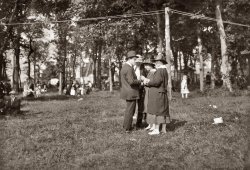
- Work History: 1911
- ... Room No. 1, Merrimac Mill, one year. Photo and caption by Lewis Wickes Hine. View full size.
(The Gallery, Kids, Lewis Hine) ... Posted by Dave - 01/16/2013 - 6:01am -
![Work History: 1911 October 1911. Lowell, Mass. Standing: Michael Keefe, 32 Marion St., been at work in No. 1 mule room, Merrimac [Textile] Mill, eight months. Apparently 13 years old. John Risheck, 391 Adams St.; Cornelius Hurley, 298 Adams St., been at work in No. 1 mule room in Merrimac Mill for six months. About 13 or 14 probably. Sitting: John Neary, 211 Lakeview Ave.; smallest is Robert Magee, 270 Suffolk St. Apparently 12 years old. Been working in Mule Room No. 1, Merrimac Mill, one year. Photo and caption by Lewis Wickes Hine. View full size.
(The Gallery, Kids, Lewis Hine)](https://www.shorpy.com/files/images/SHORPY_02396u.thumbnail.jpg)
- Tiny Shucker: 1912
- ... Canning Co. Port Royal, South Carolina." Photograph by Lewis Wickes Hine. View full size.
I've consumed many an oyster But ... Posted by Dave - 03/14/2016 - 2:14pm -
![Tiny Shucker: 1912 February 1912. "Tiny, a seven-year-old oyster shucker (sister of Henry, No. 3291), does not go to school. Works steady. Been at it one year. Maggioni Canning Co. Port Royal, South Carolina." Photograph by Lewis Wickes Hine. View full size.
I've consumed many an oysterBut have shucked nary a one. Still, judging from the heavy gloves sturdy adults use when performing that task, I am surprised that this poor little waif has any hands left. I presume, of course, that she hadn't a tiny pair of work gloves, given her obvious place in the socio-economic hierarchy of Port Royal.
Child LaborPoor kid already looks like someone's grandma.
The other side of seafoodNo idea what it's like today, but I saw a lot of how the seafood industry worked in Florida in the mid-1960s. My dad, for a couple of years, was manager of what was at that time the largest seafood company in the U.S. To teach me the value of an education, he arranged for me to work at one of the plants in Marathon, Florida, that "processed" fresh mackerel. Beheading, gutting, and rinsing the fish and putting them into a wire basket was the task when the fishing boats came in, and that began at four in the morning. It took 11 cleaned fish to fill the wire basket, and you got 25 cents a basket. I was supposed to do that for a week; one day was all I could manage and I'll never forget it.
Later, when living in Apalachicola, Florida, I'd go down to the packing plants where older black women shucked oysters. These women were so skilled it was almost beyond belief, and they had worked together so long that it seemed like a social event as they joked and sang and teased each other. That proved, to me, their tough spirit and great skill. The work was not only not fun but tedious and dangerous; handling those peculiar stiff-bladed oyster knives was not something you did without paying attention. I did admire those women so and was proud they accepted me as a friend.
I think a bit misleadingI shucked oysters as a thirteen yo female in my family's restaurant in Louisiana. The leverage it takes to break the hinge on the oyster would be beyond her ability, I would say, but who knows. I would think her job would have been to break apart the clusters of oysters with a hammer to separate them for the shuckers.
[Not misleading. They used knives. She was one of hundreds. - Dave]
(The Gallery, Kids, Lewis Hine)](https://www.shorpy.com/files/images/SHORPY-05335u.thumbnail.jpg)
- Cheney Silk: 1924
- ... full size. This picture, one of the last photographs Lewis Wickes Hine made over the span of some 16 years for the National Child Labor ... Posted by Dave - 09/08/2011 - 6:51pm -
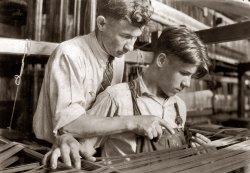
- Goes to Moving Picture Shows
- ... he receives from 15 cents to a quarter." Photograph by Lewis Wickes Hine. View full size.
The faces, part 2 Quote: Maybe a little ... Posted by Dave - 07/14/2009 - 4:21am -
![Goes to Moving Picture Shows May 1910. Wilmington, Delaware. "William Gross, 516 Tatnall Street. Newsboy, 15 years of age. Selling papers 5 years. Average earnings 50 cents per week. Father, carpenter, $18 week. Selling newspapers own choice, to get money to go to moving picture shows. Visits saloons. Smokes sometimes. "Serves papers" to prostitutes. On May 25 William gave to investigator a list of houses of prostitution written in his own handwriting, to which he serves papers. He also tells a story of occasionally guiding strangers to these houses, for which he receives from 15 cents to a quarter." Photograph by Lewis Wickes Hine. View full size.
The faces, part 2Quote: Maybe a little more hardship would do us some good.
Can't say I agree with that part of the previous post. "Today's youth" may have problems, like everyone else, but no 15 year old boy should look that sad and exhausted with life.
On the other hand, I do agree that the faces are mesmerizing.
The facesI have just been mezmerized by the faces of the children presented in the photos on this fantastic site. Every face tells a different story. These faces seem so different from those of kids today -- so much more hardship witnessed and parteken of.
We Americans have become so soft and live lives of such luxury compared with the average person even 60 years ago. Maybe a little more hardship would do us some good.
Not too brightImagine, snitching on some of your best customers, plus tips, for a lousy 50c a week job? There must have been a substantial reward for turning in prostitutes in those days to do something that stupid. Today he could have built up a promising career in Washington.
[I suspect the reason was more self-preservation than any lack of smarts - Dave]
(The Gallery, Kids, Lewis Hine)](https://www.shorpy.com/files/images/03619u_0.thumbnail.jpg)
- Other Small Ones: 1912
- ... room from 7 a.m. to 5:30 p.m. with no let-up." Photo by Lewis Wickes Hine. View full size.
(The Gallery, Factories, Lewis Hine) ... Posted by Dave - 04/26/2017 - 8:05am -
![Other Small Ones: 1912 January 1912. Fall River, Mass. "In this group are some of the youngest workers in Spinning Room of Cornell Mill. The smallest is Jo Benevidos, 5 Merion Street. Other small ones are: John Sousa, 84 Boutwell St.; Anthony Valentin, 203 Pitman St.; Manuel Perry, 124 Everett St.; John Travaresm [Taveresm?], 90 Cash St. The difficulty they had in writing their names was pathetic. When I asked the second hand in charge of the room to let the boys go outside a moment and let me get a snap-shot, he objected, saying they would stay out and not be in shape to work. When they carry dinners, they breathe the close air of the spinning room from 7 a.m. to 5:30 p.m. with no let-up." Photo by Lewis Wickes Hine. View full size.
(The Gallery, Factories, Lewis Hine)](https://www.shorpy.com/files/images/SHORPY-02505u.thumbnail.jpg)
- Horseplay: 1916
- ... Fall River, Massachusetts. View full size. Photo by Lewis Wickes Hine. What else are these boys up to? Read on.
(The Gallery, Lewis ... Posted by Dave - 09/08/2011 - 1:01pm -
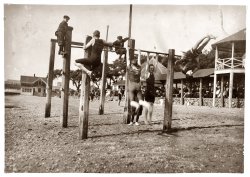
- Resting Comfortably: 1918
- ... Hospital No. 1 at Neuilly, France." 5x7 glass negative by Lewis Wickes Hine. View full size.
Battle of the Marne All the Doughboy ... Posted by Dave - 03/27/2017 - 7:59pm -
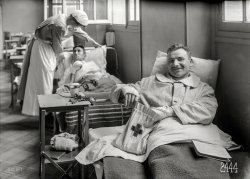
- A Fast Crowd: 1916
- ... River, Massachusetts. View full size. Photograph by Lewis Wickes Hine.
(The Gallery, Lewis Hine, Sports) ... Posted by Dave - 09/08/2011 - 1:06pm -
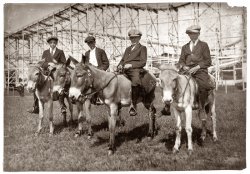
- Peyton Place: 1916
- ... Wearing short dresses." View full size. Photograph by Lewis Wickes Hine.
(The Gallery, Kids, Lewis Hine) ... Posted by Dave - 09/08/2011 - 1:02pm -
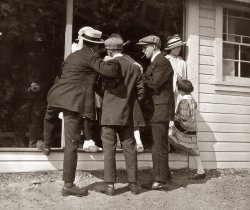
- Oscar Reynolds: 1916
- ... shoulder droops. View full size. Photo and caption by Lewis Wickes Hine.
(The Gallery, Kids, Lewis Hine) ... Posted by Dave - 12/19/2007 - 4:52am -
![Oscar Reynolds: 1916 June 18, 1916. Fall River, Massachusetts. Oscar Reynolds, 47 Benjamin Street. Fifteen years old. Sweeper in the mill. Two years in Osborne. Was in crap game [subject of another photo]. Note posture. Works overtime nearly every week. Had rather go to school. Does not like the mill. Has been sweeper two years and one shoulder droops. View full size. Photo and caption by Lewis Wickes Hine.
(The Gallery, Kids, Lewis Hine)](https://www.shorpy.com/files/images/03006u.thumbnail.jpg)
- Young Will: 1908
- ... five years." View full size. Photograph and caption by Lewis Wickes Hine.
(The Gallery, Lewis Hine) ... Posted by Dave - 05/08/2008 - 11:11am -

- Henry and Peter: 1911
- ... spinning room, two years there. Photograph and caption by Lewis Wickes Hine. View full size.
(The Gallery, Kids, Lewis Hine) ... Posted by Dave - 08/31/2009 - 5:03am -
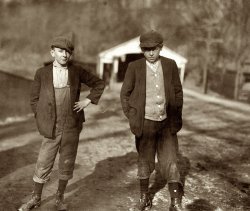
- Friday Night: 1909
- ... later than this. View full size. Photo and caption by Lewis Wickes Hine.
(The Gallery, Kids, Lewis Hine) ... Posted by Dave - 12/10/2007 - 3:20pm -
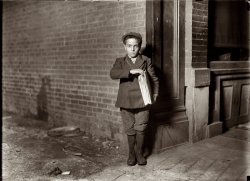
- Utility Boy: 1913
- ... several boys who might be under 15." Photo and caption by Lewis Wickes Hine. View full size.
A dollar a day $1 a day sounds terrible ... Posted by Dave - 09/28/2012 - 1:16pm -
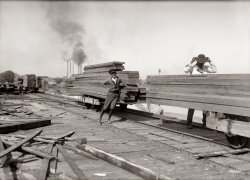
- Hard Worker: 1913
- ... from $15 to $18 a week. Eugene Dalton." Photograph by Lewis Wickes Hine. View full size.
If you're going to do cocaine, marry ... Posted by Dave - 11/20/2013 - 5:21pm -
![Hard Worker: 1913 The incorrigibly industrious Eugene Dalton 100 years ago -- we last saw him in 2007, in the second photo ever posted on Shorpy.
November 1913. Fort Worth, Texas. "Some results of messenger and newsboy work. For nine years this 16-year-old boy has been newsboy and messenger for drug stores and telegraph companies. He was recently brought before the Judge of the Juvenile Court for incorrigibility at home. Is now out on parole, and was working again for drug company when he got a job carrying grips in the Union Depot. He is on the job from 6 A.M. to 11 P.M. (seventeen hours a day) for seven days in the week. His mother and the Judge think he uses cocaine, and yet they let him put in these long hours every day. He told me 'There ain't a house in "The Acre" [Red Light] that I ain't been in. At the drug store, all my deliveries were down there.' Says he makes from $15 to $18 a week. Eugene Dalton." Photograph by Lewis Wickes Hine. View full size.
If you're going to do cocaine, marry a nurse.His draft notice says he served honorably in WWI and in 1927 he married Kathryn Brown, an R.N. Couldn't find his obit, and there's no information available on whether his two children were incorrigible, but it probably would have been poetic justice.
http://records.ancestry.com/Eugene_Trice_Dalton_records.ashx?pid=1924015...
Happy wife, happy lifeI hope he and Kathryn were able to manage a somewhat normal life after Eugene's awful teenaged years. Doesn't sound like he enjoyed much of a childhood and WW1 wasn't exactly a walk in the park for anyone.
Eugene Dalton, the second generationOnce again the 1940 Census logs come in handy. That year, Eugene was living with Katherine in Laramie, Wyoming, where he worked as a fireman for a steam railroad company. They had two children: 11-year-old Daniel Wesley Dalton and 10-year-old David Livingston Dalton. As for whether those children were incorrigible, be aware that in the Fort Logan National Military Cemetery in Colorado, there lies a former U.S. Marine named Daniel Wesley Dalton whose birth year and state matches that of Eugene's oldest son. He lived until 1979.
(The Gallery, Lewis Hine)](https://www.shorpy.com/files/images/SHORPY_03911u.thumbnail.jpg)
- Paper, Mister?
- ... the turn of the last century, featuring the photography of Lewis Wickes Hine. For maximum impact, view it in Full-Screen mode at 1080p ... Posted by Dave - 08/10/2010 - 11:38am
- Doffer & Spooler: 1908
- ... Cotton Mill doffer and spooler." Glass negative by Lewis Wickes Hine. View full size.
Child labor My mother grew up in ... Posted by Dave - 07/31/2016 - 12:41am -
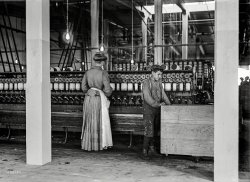
- Skeeters Branch Newsies (Oil Painting)
- Oil painting on canvas by Marek Pękacz of Lewis Wickes Hine photos of " Newsies at Skeeter's Branch , Jefferson near ... Posted by Marek Pękacz - 07/16/2019 - 4:58pm -

- Proctor, Vermont: 1910
- ... illiterate. View full size. Photo and caption by Lewis Wickes Hine.
Proctor or Rutland? Did (does?) Vermont Marble Company have ... Posted by Dave - 02/01/2008 - 11:31am -
![Proctor, Vermont: 1910 September 1910. Boy working at Vermont Marble Company in Proctor. Very illiterate. View full size. Photo and caption by Lewis Wickes Hine.
Proctor or Rutland?Did (does?) Vermont Marble Company have two plants: one in Proctor and one in Rutland, or was it just one in between the two?
[Four of the Vermont Marble photo captions say Proctor; five say Center Rutland. - Dave]
(The Gallery, Kids, Lewis Hine)](https://www.shorpy.com/files/images/04586u_0.thumbnail.jpg)























